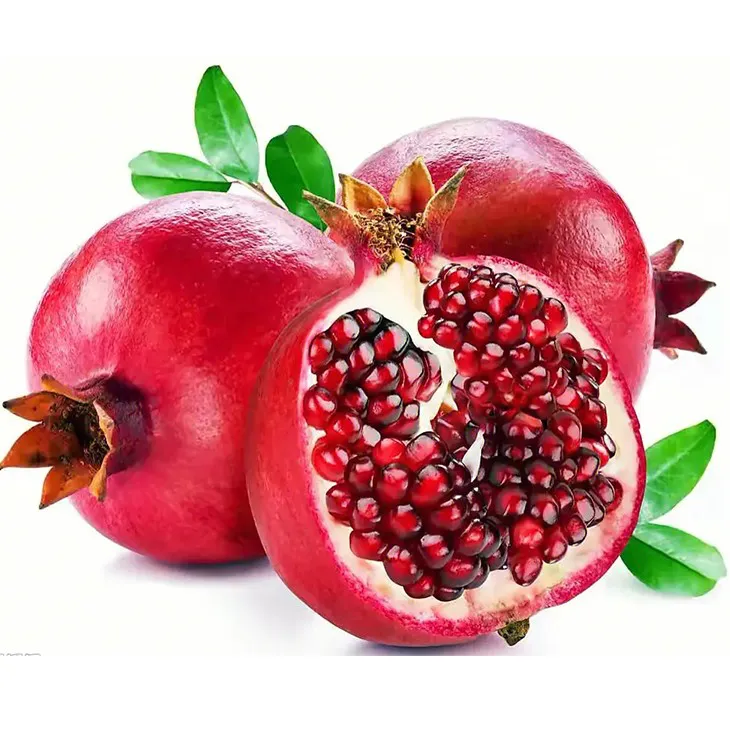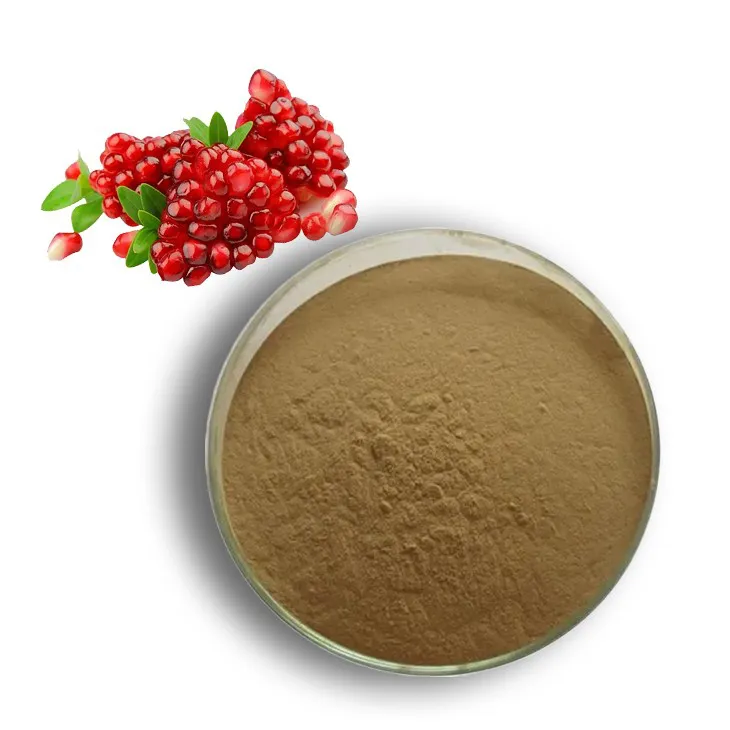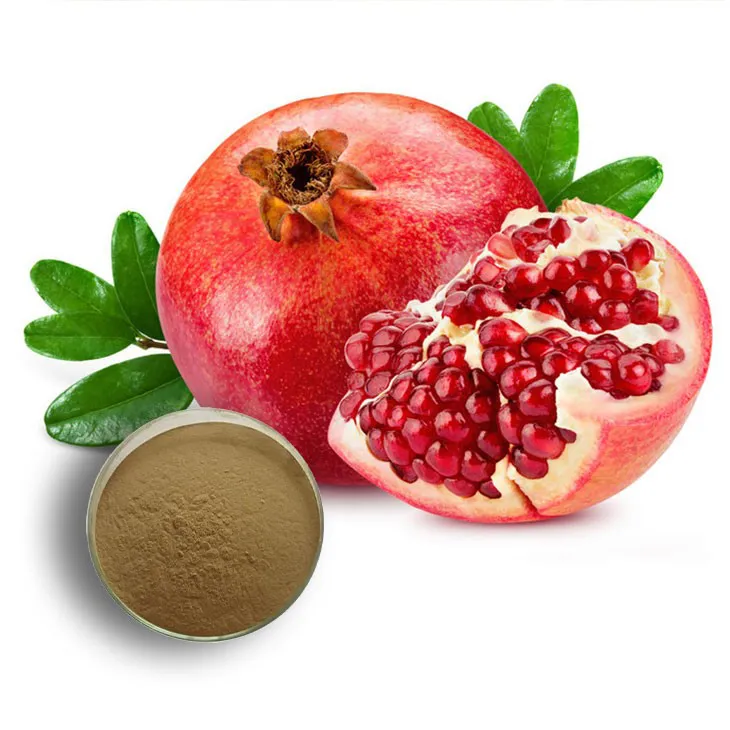- 0086-571-85302990
- sales@greenskybio.com
The process of extracting punicalagin from pomegranate extract.
2024-11-26

Introduction
Pomegranate has long been recognized as a fruit with remarkable health - promoting properties. Among the many bioactive compounds present in pomegranate, punicalagin stands out as one of the most important. Punicalagin is a polyphenol compound that has been associated with antioxidant, anti - inflammatory, and anti - cancer properties, among others. As a result, there is a growing interest in extracting punicalagin from Pomegranate Extract for use in various applications, including in the pharmaceutical, nutraceutical, and food industries.

Source of Pomegranate Extract for Punicalagin Extraction
The source of the Pomegranate Extract plays a crucial role in the extraction of punicalagin. Pomegranate can be divided into different parts, namely the peel, aril, and whole fruit, each of which has a different composition and potential for punicalagin extraction.
The Pomegranate Peel
The peel of the pomegranate is a rich source of punicalagin. It contains a relatively high concentration of polyphenols, including punicalagin. However, the peel also contains other substances that may interfere with the extraction process, such as cellulose and lignin. Therefore, special extraction methods need to be employed to effectively extract punicalagin from the peel.
The Pomegranate Aril
The aril, which is the edible part of the pomegranate, also contains punicalagin, although in a lower concentration compared to the peel. The aril has a different matrix composition, which may affect the extraction efficiency. However, the extraction from the aril may be more straightforward as it contains fewer interfering substances compared to the peel.
The Whole Pomegranate Fruit
Using the whole pomegranate fruit for extraction can provide a more comprehensive source of punicalagin. It combines the punicalagin present in both the peel and the aril. However, this also means dealing with a more complex matrix, which requires careful consideration of the extraction method to ensure optimal punicalagin recovery.

Extraction Methods
There are several methods available for extracting punicalagin from pomegranate extract, each with its own advantages and limitations.
Solvent Extraction
Solvent extraction is one of the most commonly used methods for extracting punicalagin. Different solvents can be used, depending on the solubility of punicalagin and the nature of the pomegranate extract. Common solvents include ethanol, methanol, and water. Ethanol is often preferred due to its relatively good solubility for punicalagin and its safety for use in food - related applications.
The solvent extraction process typically involves the following steps:
- Preparation of the sample: The pomegranate extract (from peel, aril or whole fruit) is ground into a fine powder to increase the surface area for extraction.
- Mixing with the solvent: The powdered sample is mixed with the selected solvent in a suitable ratio. This is usually done under agitation to ensure thorough mixing.
- Extraction time: The mixture is allowed to stand for a certain period of time, usually ranging from a few hours to several days, depending on the nature of the sample and the desired extraction efficiency.
- Separation: After the extraction time, the mixture is filtered or centrifuged to separate the liquid extract (containing punicalagin) from the solid residue.
Enzymatic Hydrolysis
Enzymatic hydrolysis can be used in combination with solvent extraction to improve the extraction efficiency of punicalagin. Pomegranate extracts contain complex matrices, such as polysaccharides and proteins, which can bind to punicalagin and make it difficult to extract. Enzymes can break down these complex matrices, releasing punicalagin and making it more accessible for solvent extraction.
Common enzymes used for this purpose include cellulases, pectinases, and proteases. The enzymatic hydrolysis process generally involves:
- Enzyme selection and preparation: Select the appropriate enzymes based on the composition of the pomegranate extract. Prepare the enzyme solution according to the manufacturer's instructions.
- Mixing with the sample: Add the enzyme solution to the pomegranate extract sample and mix well. The pH and temperature of the mixture need to be adjusted to the optimal conditions for the enzyme activity.
- Hydrolysis time: Allow the enzymatic hydrolysis to proceed for a specific period of time, during which the enzymes break down the complex matrices.
- Subsequent solvent extraction: After the enzymatic hydrolysis, solvent extraction is carried out as described above to extract punicalagin from the hydrolyzed sample.
Supercritical Fluid Extraction
Supercritical fluid extraction (SFE) is an emerging extraction method that has shown promise for punicalagin extraction. In this method, a supercritical fluid, typically carbon dioxide (CO₂), is used as the extraction solvent. Supercritical CO₂ has properties between those of a gas and a liquid, which gives it unique extraction capabilities.
The advantages of SFE for punicalagin extraction include:
- Low toxicity: CO₂ is non - toxic, making it a safe option for food and pharmaceutical applications.
- High selectivity: It can selectively extract punicalagin while leaving behind other unwanted substances.
- Easy solvent removal: After extraction, the CO₂ can be easily removed by reducing the pressure, leaving behind a relatively pure punicalagin extract.
However, SFE also requires specialized equipment and higher operating costs compared to traditional solvent extraction methods.

Purification of Punicalagin
After extraction, the punicalagin - containing extract usually needs to be purified to obtain a high - quality product suitable for various applications. One of the most effective purification techniques is high - performance liquid chromatography (HPLC).
High - Performance Liquid Chromatography (HPLC)
HPLC is a powerful analytical and preparative technique for separating, identifying, and purifying compounds. In the case of punicalagin purification, HPLC can separate punicalagin from other co - extracted substances based on their different chemical properties, such as polarity and molecular size.
The HPLC process for punicalagin purification typically involves:
- Column selection: Select an appropriate HPLC column based on the characteristics of punicalagin. Reverse - phase columns are often used for polyphenol compounds like punicalagin.
- Mobile phase preparation: Prepare a suitable mobile phase, which is a liquid that flows through the column and carries the sample components. The composition of the mobile phase can be adjusted to optimize the separation of punicalagin.
- Sample injection: Inject a small volume of the punicalagin - containing extract into the HPLC system.
- Separation and detection: As the sample travels through the column, punicalagin is separated from other components based on its interaction with the column and the mobile phase. The separated punicalagin is then detected by a detector, such as a UV - Vis detector, based on its absorbance at a specific wavelength.
- Collection of purified punicalagin: The purified punicalagin fraction can be collected for further use.

Conclusion
The extraction of punicalagin from pomegranate extract is a complex process that involves careful consideration of the source of the extract, the extraction method, and the purification process. Different sources of pomegranate extract, such as the peel, aril, or whole fruit, offer different potential for punicalagin extraction. Solvent extraction, enzymatic hydrolysis, and supercritical fluid extraction are among the available extraction methods, each with its own advantages and limitations. Purification by HPLC ensures the high quality of the final punicalagin product, which can then be used in research, medicine, and functional foods. As the demand for natural bioactive compounds like punicalagin continues to grow, further research and development in the extraction and purification processes are expected to improve the efficiency and quality of punicalagin production.
FAQ:
What are the main factors affecting the extraction of punicalagin from pomegranate extract?
The main factor is the source of the pomegranate extract, whether it is from the peel, aril or whole fruit. Different sources may have different compositions and structures, which will affect the extraction process.
Why is enzymatic hydrolysis used in the extraction of punicalagin?
Enzymatic hydrolysis can be combined with solvent extraction. It helps to break down complex matrices in the pomegranate extract, so that punicalagin can be released more effectively, increasing the extraction efficiency.
What is the role of high - performance liquid chromatography (HPLC) in the extraction of punicalagin?
HPLC is used for purification. It ensures that the final product of punicalagin is of high quality by removing impurities, which makes it suitable for use in research, medicine and functional foods.
Are there other extraction methods for punicalagin?
Yes, besides the combination of enzymatic hydrolysis and solvent extraction, there may be other methods. However, the current combination method aims to optimize the yield and purity of punicalagin effectively.
What are the applications of punicalagin extracted from pomegranate extract?
Punicalagin can be used in research, medicine and functional foods. In research, it can be studied for its biological activities. In medicine, it may have potential health - promoting effects. In functional foods, it can be added to enhance the nutritional value.
Related literature
- Extraction and Characterization of Punicalagin from Pomegranate Peel"
- "Optimization of Punicalagin Extraction from Pomegranate Fruit for Nutraceutical Applications"
- "Punicalagin: A Key Bioactive Compound in Pomegranate - Recent Advances in Extraction and Analysis"
- ▶ Hesperidin
- ▶ citrus bioflavonoids
- ▶ plant extract
- ▶ lycopene
- ▶ Diosmin
- ▶ Grape seed extract
- ▶ Sea buckthorn Juice Powder
- ▶ Beetroot powder
- ▶ Hops Extract
- ▶ Artichoke Extract
- ▶ Reishi mushroom extract
- ▶ Astaxanthin
- ▶ Green Tea Extract
- ▶ Curcumin Extract
- ▶ Horse Chestnut Extract
- ▶ Other Problems
- ▶ Boswellia Serrata Extract
- ▶ Resveratrol Extract
- ▶ Marigold Extract
- ▶ Grape Leaf Extract
- ▶ blog3
- ▶ blog4
-
Nature's Bounty Maitake Mushroom Extract.
2024-11-26
-
100% Pure Natural Fructus Aurantii Extract.
2024-11-26
-
100% Organic Fig Extract.
2024-11-26
-
Chinese Rose Hip Extract Powder Factory.
2024-11-26
-
Sophora Japonica Flower Extract
2024-11-26
-
Buckthorn bark extract
2024-11-26
-
White Willow Bark Extract
2024-11-26
-
Passionflower Extract
2024-11-26
-
Black Rice Extract
2024-11-26
-
Green Tea Extract
2024-11-26
-
Lycopene
2024-11-26
-
Okra Extract
2024-11-26
-
Bamboo Leaf extract
2024-11-26
-
Ginseng Root Extract
2024-11-26





















